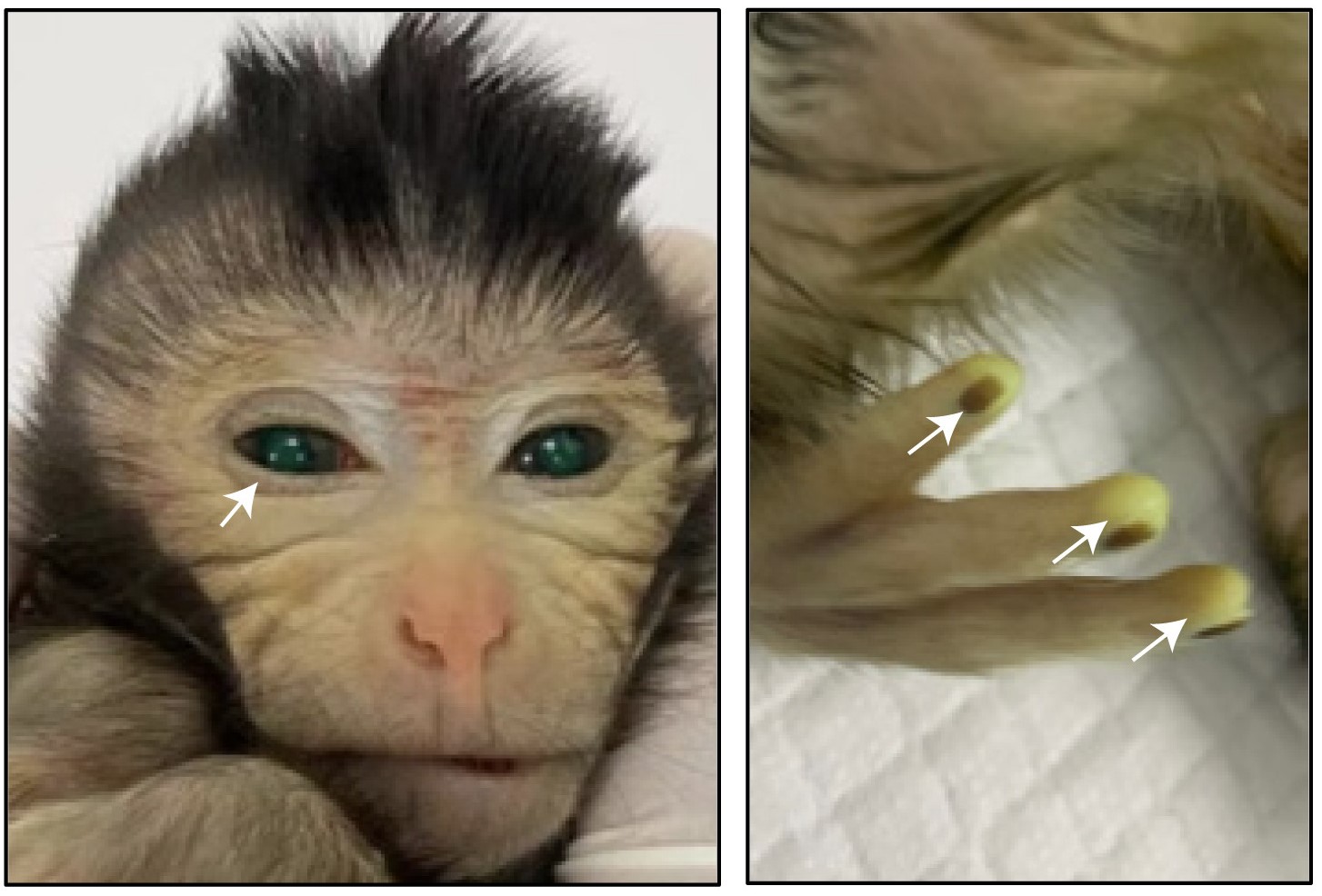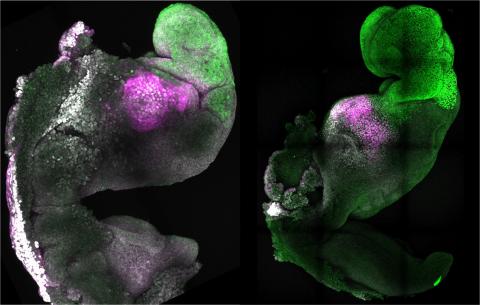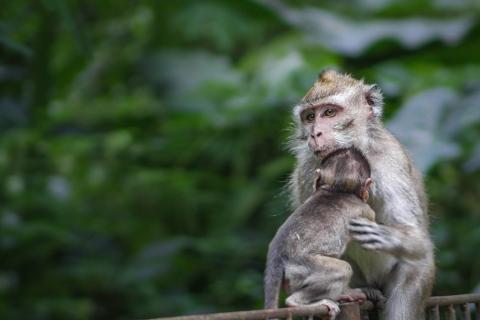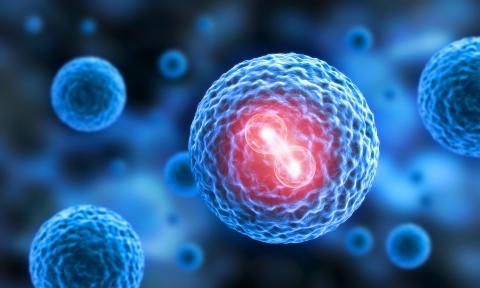Reactions: First chimeric monkey born from embryonic stem cell lines
A Chinese research team has reported the birth of a crab-eating macaque that is a chimera: an animal generated from the mixing of embryonic cells from two different individuals; in this case, from the same species, according to the journal Cell. Until now, this type of chimera had only been developed with rodents. This is the first time it has been achieved in non-human primates.

The research team used a green fluorescent protein to detect tissues containing injected stem cells. In these images, the fluorescent signals can be seen in different parts of the body of the three-day-old chimeric monkey. Photo credit: Cell / Cao et al.
mono quimérico - Estrella Nunez EN
Estrella Núñez Delicado
Professor of Biochemistry, Vice-Chancellor for Research
This work is a strong proof-of-principle demonstrating that chimerism—with high levels of donor cell contribution from autologous pluripotent stem cells—is possible through early embryo complementation in non-human primates (cynomolgus monkey). This had been achieved before in rodents. In primates, it has been more challenging.
A few years ago, our research group at UCAM pioneered the studies of chimerism with iPS cells in primates—with the ultimate goal of generating transplantable human organs to treat irreversible diseases. This study builds on that direction and paves the way for complex genome engineering of monkeys, the same way that chimerism revolutionised mouse genetics and mouse model diseases in the past century. The clinical implications of these and our studies are very relevant, since they will facilitate human disease modelling studies in non-human primates. It also has major implications for species conservation.
mono quimérico - Lluis Montoliu EN
Lluís Montoliu
Research professor at the National Biotechnology Centre (CNB-CSIC) and at the CIBERER-ISCIII
In 1984, British researcher Allan Bradley demonstrated that it was possible to generate chimeric mice with a high contribution of embryonic pluripotent cells injected into pre-implantation embryos, in blastocysts. The resulting chimeric mice were also able to transmit the genome of the injected cells to their offspring after colonisation of the gonads. This experiment triggered a series of advances that led to the birth of the first mutant mouse in 1989, generated from mutations introduced into embryonic pluripotent cells. This technology, which made it possible to understand the function of thousands of mouse genes (and, by comparison, our genes), was awarded the Nobel Prize for Medicine in 2007, and the winning researchers were Mario Capecchi, Martin Evans (Allan Bradley's boss) and Oliver Smithies. For years, this technology could only be used in mice. In 2008, embryonic pluripotent rat cells with the ability to colonise chimeras were obtained, but for all other species, including primates, this technique was not technically possible.
Nearly 40 years later, a large team of researchers in China has just demonstrated that they can repeat Bradley's experiment in macaques—with a very modest, but still remarkable efficiency. They generated the first chimeric macaques by microinjecting pluripotent macaque embryonic cells, obtained from embryos and maintained under very specific culture conditions. These cells, labelled with a gene that fluorescently colours the cells derived from them green, have managed to colonise all the organs of the resulting chimeric monkey. Between 20 and 90% of the cells in each organ have developed from the original injected embryonic pluripotent cells. This includes the gonads, the testes (the two chimeric monkeys they have been able to analyse, one aborted and one that survived birth, were both male). This suggests that this chimeric macaque is likely to be able to transfer the genome of the injected embryonic cells to its offspring, something the researchers will have to undertake soon.
This is an experiment that is not novel in the animal world (we have known how to do this very effectively in mice for forty years) but it is novel in primates, such as the macaque used here, which brings this methodology closer to its possible use in humans—which ethically, scientifically and technically would neither be feasible today, nor justified. Reviewing the research team's figures gives us an idea of what might happen if this experiment were attempted in another primate species, such as humans. They obtained 206 macaque embryos at the morula stage and injected them with pluripotent embryonic cells. Of these morulae, 91 reached the blastocyst stage and 74 could be implanted into (no less than) 40 females, experimentally prepared to accept and maintain gestation to term. They obtained 12 gestations of which 2 aborted early, 4 during foetal development and 6 went to term. Of these, only one macaque survived with a high chimeric contribution of embryonic cells. One chimeric macaque out of 206 embryos: a very low efficiency of about 0.5%.
The relevance of this experiment opens the door to the possible generation of chimeric monkeys that carry specific mutations, initially introduced in pluripotent embryonic cells, and that serve to investigate diseases that affect us humans. However, this technology comes ten years too late. Since 2013, we have known how to use CRISPR gene editing tools, which are very useful to mutate genes in a very precise and specific way directly in embryos of any animal species. In 2014, they were already used to generate mutant macaques without the need to use chimeric monkeys or pluripotent embryonic cells. In other words, biologically it is a significant advance to be able to generate these chimeric macaques from embryonic pluripotent cells, but in practice, almost everything we could do with this technique has been possible for years thanks to CRISPR tools.
The very low efficiencies in the generation of chimeric macaques are very similar to those obtained when 21 years after the birth of Dolly the sheep, the first mammal cloned from adult cells, the first cloned macaques were obtained in 2018, with an efficiency similar to that reported for the most famous sheep, again around 1%.
Finally, it is important to note that this experiment, which is published in the prestigious journal Cell, could not have been carried out in Europe, since our European legislation on animal experimentation prevents the use of non-human primates such as these macaques in scientific experiments—unless it is to investigate very serious, fatal diseases that affect us. Since this experiment is a first proof of concept and is not intended to investigate any disease, it would not have obtained the necessary permission to be carried out in any EU country. This explains why all the advances in non-human primate reproductive biology that we have seen in recent years have come from experiments in China, the United States, Japan and Korea—not from Europe.
mono quimérico - Alfonso Martínez EN
Alfonso Martínez Arias
ICREA research professor senior and researcher in Bioengineering Systems-MELIS at Pompeu Fabra University
In this study, the authors report the birth of monkeys with a high degree of somatic chimerism from the fusion of embryonic stem cells with a blastocyst [an embryo at 5 or 6 days of development after fertilisation]. A chimera is an organism composed of cells with different genetic identities. This work represents an important milestone in mammalian developmental biology, particularly that of primates and, by extension, human biology.
Embryonic stem cells (ESCs) represent a source of important applications for fundamental biology and biomedicine. The fundamental property of these cells is their pluripotency, their ability to contribute to all the organs of an organism, something that is tested with chimeras. This technique was fine-tuned in mice. Cells are put into a blastocyst where they are mixed. The blastocyst is implanted and allowed to develop, the result is a mouse in which all the tissues are a mixture of the two kinds of cells. So, for example, if cells from a black mouse are used with the blastocyst from a white mouse, the mouse will have a random mixture of the two cell types and will have a mixture of black and white fur.
In the case of humans, this experiment is not possible and other techniques are used to test the pluripotency of the cells, such as the generation of teratomas (benign tumors with cells from multiple tissues) in mice which, although approximate, are not the same. For this reason, the pluripotency of human embryonic cells does not yet have reliable proof.
The last ten years have seen great advances in the use of these cells with the development of several protocols leading to the generation of a wide variety of organs and tissues in vitro from ESCs. However, in the case of humans, proof of their pluripotency through chimeras is still lacking. If they could be done, these experiments would open the door to the generation of disease models and details of human biology. But, of course, the experiments are not ethically possible.
Non-human primates offer an alternative possibility, because - although under the control of strict ethical standards, and very costly - the experiments would, in principle, be possible. In this paper, a Chinese research group, including the Spaniard Miguel Esteban, report work in this direction.
The authors obtain embryonic stem cells from cynomolgus monkeys, make them fluorescent and use them to generate chimeras. The chimeras provide a very strong test of the potential of embryonic stem cells and the authors test several methods of growing the cells before doing the experiment. They show that only one of these methods generates cells with the ability to interact with embryonic cells to give rise to an organism. The work is important and has several conclusions that provide valuable information about, and for, the field.
The first, for me, is that not all embryonic stem cells are the same: depending on the method of isolation and growth, they have different properties. To me this is surprising, and it is important, as [scientists] work with many culture media on the assumption that they are all the same. This work clearly demonstrates that this is not the case. In the most demanding experiment, cells that, from many points of view, look the same are actually not the same. More work will be needed, but this observation is important. The second point that is surprising to me is the low number of chimeras. Starting with 206 experimental embryos, they obtain 6 live births, and some with difficulties then die. The high degree of miscarriages is sobering.
The good news is that chimeras have been obtained and that we are beginning to know the reasons why a previous experiment in a similar line did not work. The culture medium in which ESCs grow is crucial in determining their status, and only some [media] put the cells in a state that is compatible with embryonic development.
The work represents a milestone and is rich in detail and clues as to what these ESCs are. It opens the way for the use of nonhuman primates as a model for human biology, for example, in studying the effects of genetic modifications and disease models. But these are not experiments accessible to any biologist. They are very expensive and require special facilities. Also the gestation period and the fact that there is only one baby per mother make it difficult. We will have to wait to see if [this result] goes beyond proof of principle.
mono quimérico - Jacob Hanna EN
Jacob Hanna
Professor of Stem Cell Biology & Embryology at Laboratory for Pluripotent Cell Studies and Ex Utero Embryogenesis at the Weizmann Institute of Science (Israel)
This is a very good and important paper. It shows in primates what we know in rodents: that naive pluripotent stem cells are capable of integrating into developing blastocysts, and then [once implanted in] the uterus, can contribute to all tissues in developing a viable monkey embryo. The results of this study are solid.
For years, scientists didn't know if naive pluripotent cells are a rodent-specific phenomenon. In 2013, our group (Gafni et al. Nature 2013) showed that they exist in humans, and since then this has become an active area of research where multiple types of naive stem cells have been derived in humans and in primates. Of course, chimera experiments cannot and must not be done with human embryos (this would be unethical and illegal), so it is important to demonstrate this proof of concept in monkeys.
This study may contribute to easier and better making of mutant monkeys, just like biologists have been doing for years with mice. Of course, working with non-human primates is slower and much harder than with rodents, but it is important. As we have recently showed also, naive human stem cells [are capable of making] complete human embryo models (Oldak et al. Nature 2023), thus this might be relevant also to monkeys.
Jing Cao et al.
- Research article
- Peer reviewed
- Experimental study
- Animals



